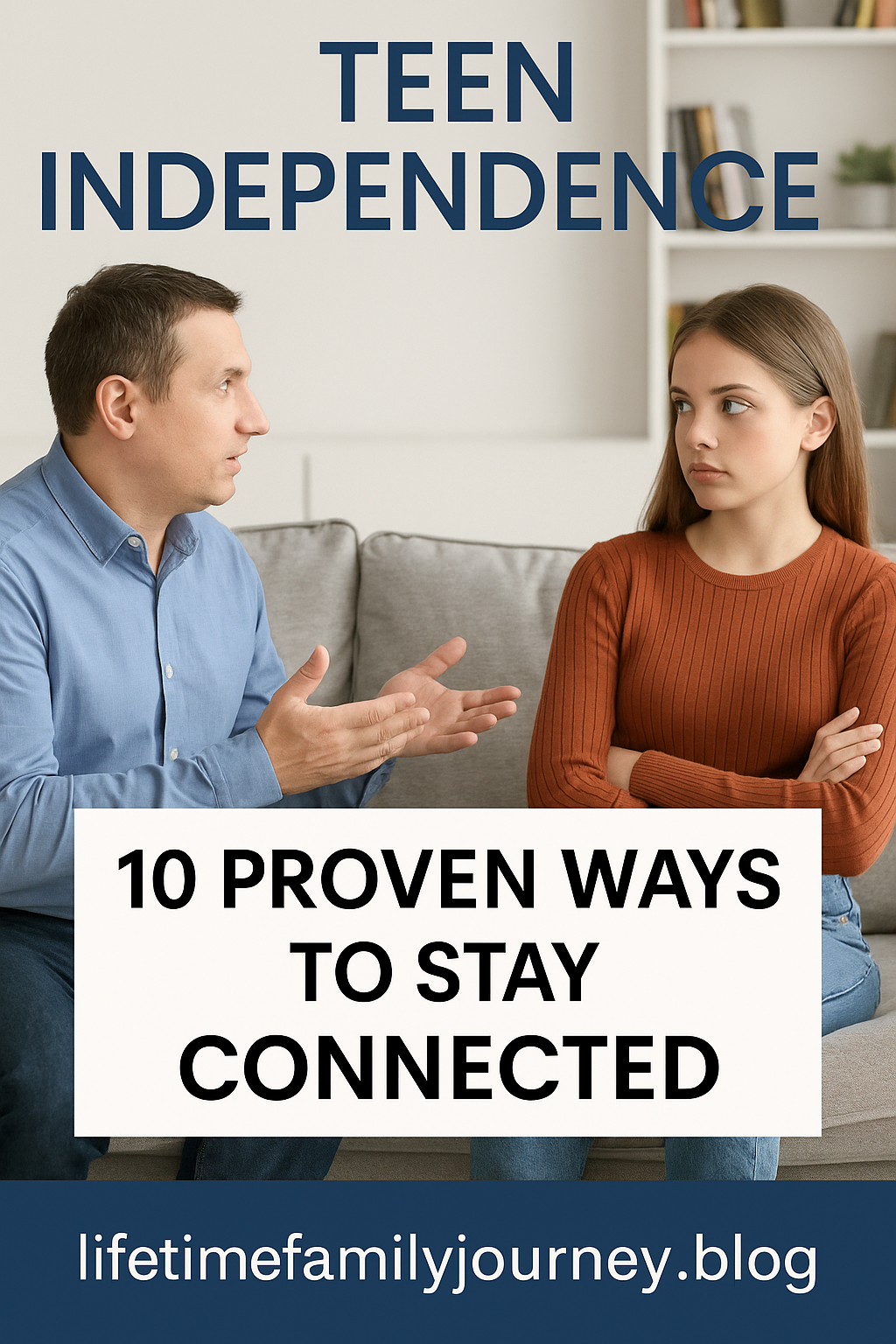Teen Independence: 10 Proven Ways to Stay Connected
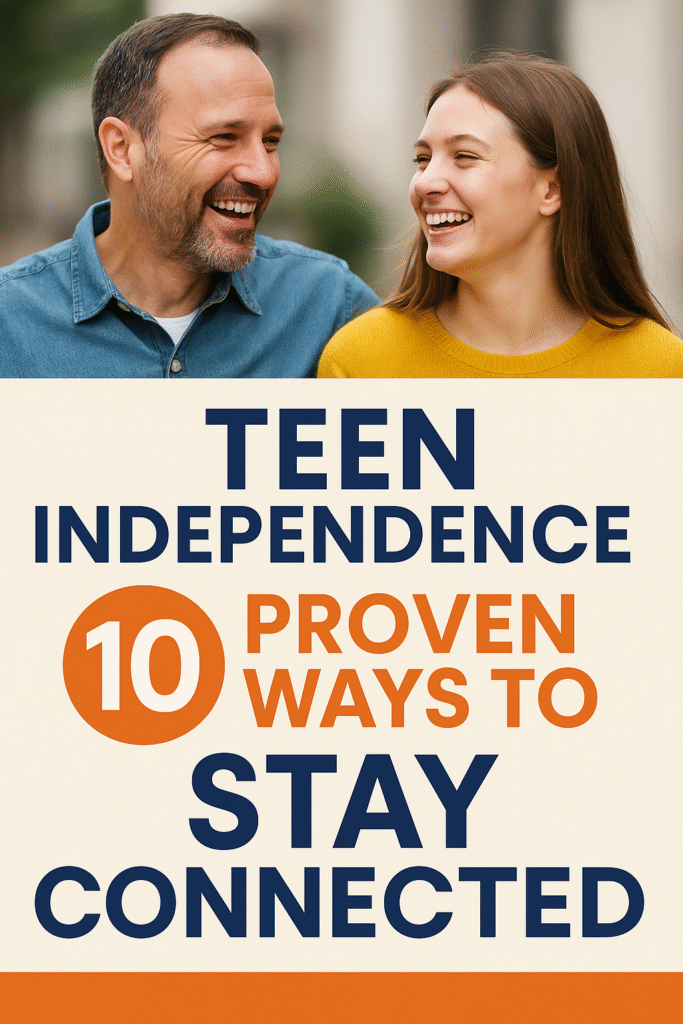
It’s Tuesday night, and I’m watching my son negotiate his curfew like he’s closing a business deal. 📋 Meanwhile, my daughter just borrowed the car keys for what feels like the twentieth time this month, and another teen has music blasting from behind a firmly closed door. 🎵🚪
This is life with four teenagers simultaneously, and let me tell you—some days it feels less like parenting and more like hostage negotiation. 😅
But here’s what I’ve discovered through the chaos: teen independence isn’t the enemy of family connection. It’s actually proof that we’re doing our job right. 🎯 The challenge is learning how to nurture that growing independence while keeping the bonds we’ve worked so hard to build.
Understanding Why Teen Independence Is Essential
The push toward autonomy isn’t teenage rebellion—it’s biological imperative. 🧠 According to developmental psychology research, adolescents who develop age-appropriate independence show:
→ Better decision-making skills
→ Higher self-esteem
→ Stronger family relationships long-term
I remember when Natalie first asked to go to a concert two hours away with friends. 🎵 Every parental instinct screamed “absolutely not,” but I realized my anxiety wasn’t about her capability—it was about my comfort zone. That night, watching her return home glowing with pride about navigating public transportation and managing her own evening, taught me something crucial: teen independence isn’t about them leaving us behind. It’s about us raising humans capable of thriving in the world.
Research published by the American Psychological Association confirms what I’ve observed firsthand. Teens who gradually gain independence in supportive environments develop stronger problem-solving abilities and healthier relationships with authority figures, including their parents.
The key word here is “gradual.” Just like learning to drive, fostering teen independence requires removing the training wheels slowly, running alongside them until they find their balance, then being available when they need support. 🚗💨
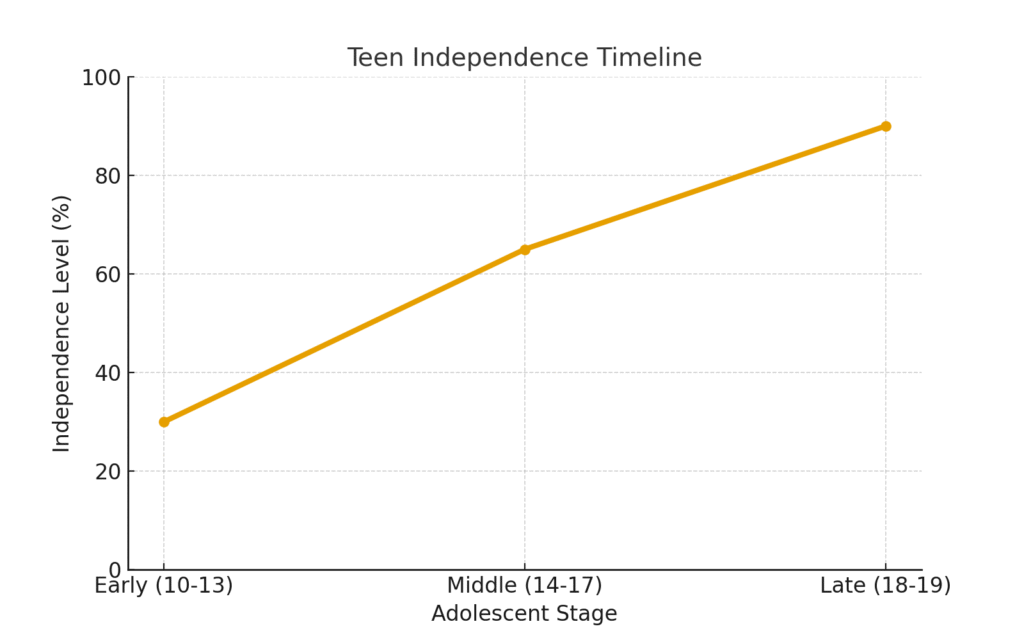
The Parent Balancing Act
Every parent of a teenager knows this internal struggle: the constant push and pull between protecting them from the world and preparing them for it. We want to keep them safe, but we also know that overprotection can be just as damaging as neglect. 🤹♀️
I’ve watched parents at both extremes—the helicopter moms who track their teens’ every move and the free-range parents who seem to have no boundaries at all. Neither approach felt right for our family. The helicopter approach breeds resentment and doesn’t teach real-world skills, while the completely hands-off approach can leave teens feeling abandoned just when they need guidance most.
The Sweet Spot: “Scaffolded Independence” Think of it like removing training wheels gradually—you don’t just take them off and push your kid down a hill. You run alongside them, ready to catch them if needed, but letting them feel the freedom of balancing on their own. 🚴♀️
Sometimes this looks like:
• Letting them plan weekend activities + asking for one check-in 📱
• Letting them handle teacher conflicts alone + being available for advice 🎓
• Biting your tongue when they make choices you wouldn’t (if they’re safe) 🤐
If I tracked their phones any harder, the Pentagon would probably ask me for tips. But I’ve learned that constant monitoring sends the message that I don’t trust them, which becomes a self-fulfilling prophecy. Trust breeds trustworthiness—most of the time. 📍
1. Create Communication That Actually Works 💬
Traditional parent-teen communication often sounds like interrogation:
❌ “Where are you going?”
❌ “Who will be there?”
❌ “When will you be back?”
Instead, I’ve learned to approach conversations with genuine curiosity rather than fear-based questioning. 🤔
Have you ever noticed how teens will talk your ear off about something they’re passionate about, but clam up the moment you ask about school? That’s because they can sense the difference between authentic interest and parental worry disguised as questions.
The Magic Formula:
• Car rides = Best conversations 🚗
• No direct eye contact = Safer sharing
• Listen first, advise second ✨

Our best conversations happen during car rides or while doing mundane tasks together. There’s something about not making direct eye contact that makes sharing feel safer for them. I’ve learned more about my kids’ lives during twenty-minute drives to guitar lessons than during months of attempted dinner table discussions.
The magic happens when you listen first and advise second. Now I ask, “Do you want me to help you problem-solve this, or do you just need someone to hear you?” Nine times out of ten, they just want to be heard. 👂
Building strong family communication strategies has become one of our most important investments. When teens feel genuinely heard, they’re more likely to share the important stuff—and more willing to accept guidance when they actually need it.
We also try to connect these everyday conversations to bigger values—like when we discuss charitable giving and making a real impact in our community. These discussions help them see beyond their immediate world while still respecting their growing independence.
2. Set Boundaries That Build Trust 🤝
Boundaries with teenagers require a completely different approach than rules for younger children. You can’t just lay down the law and expect compliance. Instead, successful boundaries involve teens in the creation process.
The Collaborative Approach:
→ Discuss rather than dictate
→ Consider context (school night vs weekend)
→ Reward reliability with flexibility
→ Make consequences logical, not punitive
Take curfews, for example. Rather than declaring “midnight is your curfew,” we have family discussions about what makes sense for specific situations. A school night hangout has different parameters than a weekend celebration. A teen who consistently proves reliability earns more flexibility than one still learning responsibility. 🕐

The goal isn’t control—it’s teaching self-regulation. When Kaelyn wanted to extend her weekend curfew, instead of simply saying yes or no, we talked through the logistics: “If you’re staying out until 1 AM, what’s your plan for not waking up Melody when you come in? And how will you manage being functional for your job Saturday morning?” 🤷♀️
When teens feel involved in creating reasonable limits, they’re infinitely more likely to respect them. Family harmony with teenagers depends on this collaborative approach to rule-setting.
Consistency matters more than perfection. If we agree the car needs to be home by 11 PM, it needs to be there at 11 PM—not 11:15, not “just this once” 11:30. But consistency also means being flexible when genuine circumstances warrant it. 💯
3. Master the Art of Stepping Back 🎭
This might be the hardest part of parenting teenagers: letting them experience natural consequences without swooping in to save them from every discomfort. Those small failures are actually gifts that teach resilience. 🎁
When Allyson’s Project Disaster Taught Me Everything:
When Allyson forgot about a major project until the night before it was due, every parental instinct urged me to:
• Help her research 📚
• Drive to the store for supplies 🏪
• Maybe even call in sick to assist 😵💫
Instead, I took a deep breath and said, “That sounds stressful. What’s your plan?” 🤷♂️
The Results:
→ She stayed up late
→ Submitted mediocre work
→ Received a lower grade than usual
→ Learned time management that no lecture could teach
The Child Mind Institute emphasizes that constantly rescuing teens from consequences robs them of opportunities to develop problem-solving skills. Small failures in safe environments—forgetting homework, missing a shift at work, running out of spending money due to poor budgeting—are practice runs for much bigger challenges ahead.
Safe vs. Dangerous Failures:
✅ Social awkwardness from poor planning
✅ Temporary financial stress from impulse spending
✅ Academic consequences from procrastination
❌ Safety-related choices (seatbelts, etc.)
❌ Anything with lasting harm potential
4. Build Responsibility Gradually 📈
Trust isn’t something you give teenagers—it’s something they earn through demonstrated responsibility. And responsibility isn’t something you demand—it’s something you gradually transfer as they prove capable of handling it. 🏆
The Trust-Building Ladder:
• Level 1: Supervised driving 👨🏫
• Level 2: Short solo trips to familiar places 🏪
• Level 3: Longer distances 🛣️
• Level 4: Freedom for personal activities 🎉
Driving privileges have become our biggest trust-building tool. Each teen goes through the same progression, proving they can handle each level responsibly before advancing.
But responsibility extends far beyond driving. Chores evolve from “do this because I said so” to “these are your contributions to our household.” Part-time jobs teach them that time has value and money requires effort. 💰
Allyson’s First Paycheck Revelation: When Allyson received her first real paycheck, she stared at it for ten minutes. “I worked twenty hours for this,” she said. “I’m never looking at money the same way.” 🤯
Essential Life Skills Training:
→ Budgeting (managing clothing/entertainment money)
→ Home maintenance (laundry, cooking, repairs)
→ Time management (their activities, their conflicts)
The goal isn’t creating mini-adults overnight, but gradually expanding their circle of responsibility so independence feels natural rather than terrifying when they leave home.
5. Stay Connected Without Hovering 🍕
There’s an art to remaining involved in your teenager’s life without making them feel smothered. My secret weapon? Food. Specifically, lots of food. 🥪🥨🍪
The Snack Strategy:
Our house = Default hangout spot
Why? → Always stocked pantry 🏪
Result? → Comfortable teens who share naturally 💬
Our house has become the default hangout spot for my kids’ friends, entirely because of our snack game. I stock the pantry like I’m preparing for a small army—which, essentially, I am. When teenagers know there’s always food available and they’re genuinely welcomed, they’ll choose to spend time at your house. 🏠
The Beautiful Benefits:
• Observe natural friend interactions 👀
• Learn about drama without prying 🎭
• Meet their friend groups organically 🤝
• Get genuine sense of their world 🌍
Yes, you’ll go through three gallons of milk weekly. 🥛 Yes, your grocery budget will make you question life choices. 💸 Yes, it’s absolutely worth it. ✨
Better Questions That Actually Work:
✅ “Tell me about your friends” (vs “Who were you texting?”)
✅ “How was your day?” (vs “What happened at school?”)
✅ Show genuine curiosity about their interests
Sometimes staying connected means accepting that their interests differ from yours. I may not understand certain video games or social media trends, but I try showing genuine curiosity about things that matter to them. When they feel heard and respected, they’re more likely to keep sharing.
6. Navigate Technology Wisely 📱
The technology battle is real and constantly evolving. Just when you figure out Instagram, they’ve moved to TikTok. Master TikTok monitoring, and they’ve discovered some app you’ve never heard of. 🔄
The Exhausting Tech Chase:
You learn Instagram → They switch to TikTok
You master TikTok → They find new mystery app
Repeat infinitely → Parent burnout 😵💫
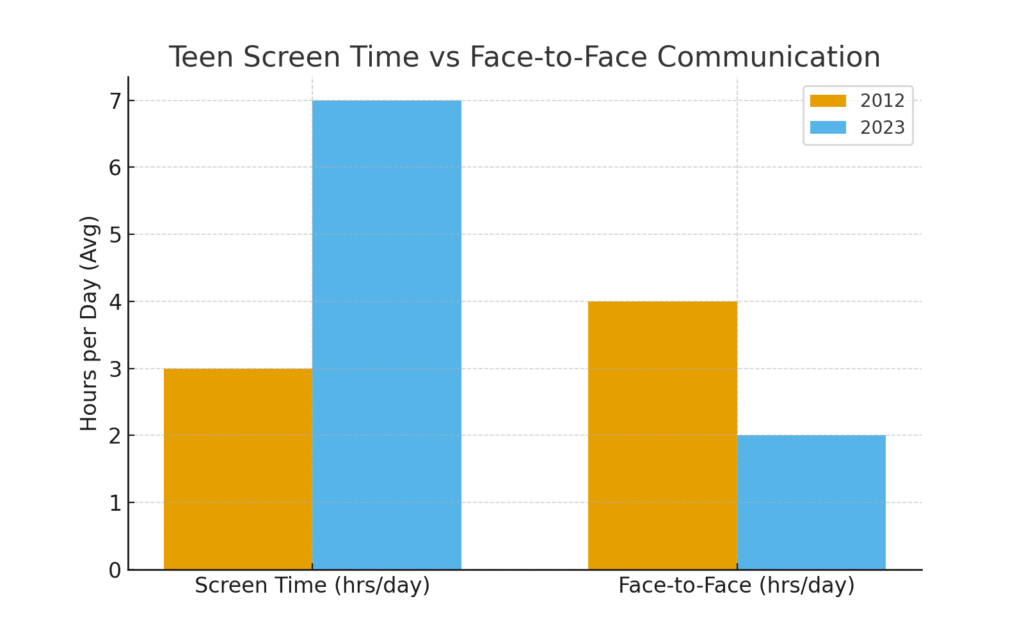
I’ve learned that trying to stay ahead of technology trends is exhausting and ultimately futile. Instead, we focus on teaching digital citizenship and gradually moving from external control to internal self-regulation.
Our Evolution:
❌ Before: Constant screen time battles
✅ Now: Conversations about healthy use + natural consequences
When Brayden stayed up until 2 AM gaming and was exhausted at school the next day, he learned more about balance than any lecture could provide. 🎮😴
Non-Negotiable Tech Boundaries:
• No phones in bedrooms overnight 🚫📱
• No social media during family time 👨👩👧👦
• Open communication about uncomfortable interactions 🗣️
• Within boundaries = significant freedom to choose ✨
Our family screen time plan has evolved over the years, but the core principle remains: teaching self-regulation rather than relying on constant external control.
The goal is preparing them for adulthood when they won’t have parents monitoring their screen time. This connects to broader parental self-care principles—we can’t control everything, and trying exhausts everyone involved.
7. Handle the Chaos of Multiple Teenagers 🎪
Parenting several teenagers simultaneously feels like conducting an orchestra where every musician plays a different song. Everyone’s in different developmental stages, has varying social needs, and requires different types of support. 🎼
Our Reality Check:
• 4 teens in different life phases 📊
• Multiple friend groups 👥
• Overlapping curfews ⏰
• Car sharing negotiations 🚗
• One laundry room chaos 🧺
Our group text basically runs like its own sitcom. Coordinating schedules, managing overlapping curfews, and tracking who needs to be where when requires military-level logistics. Systems save sanity in big family life. 📋
Weekly Family Meetings = Survival Tool:
→ Sunday evenings (with snacks!) 🍿
→ Review upcoming schedules 📅
→ Address conflicts before they explode 💥
→ Ensure everyone feels heard 👂
Essential Systems:
• Shared calendars (Google Calendar is our lifeline) 🗓️
• Clear chore charts 📝
• Communication protocols ☎️
• Individual check-in time 💙
The biggest challenge is ensuring each teen feels seen individually while managing group dynamics. Sometimes this means saying, “That sounds like something we should discuss privately” when sensitive topics arise in group settings. 🤫
The Silver Lining: We’ve learned to celebrate the benefits of having multiple teenagers. They:
✨ Support each other in ways we never could
✨ Share rides (hallelujah!) 🚗
✨ Give peer advice that actually matters 💭
✨ Provide built-in social connections 🤝
Yes, it’s chaotic, but it’s also rich and dynamic in ways single-child families might miss. 🌈
8. Adapt Family Traditions 🎊
One of my biggest fears about teen independence was losing our family traditions entirely. I worried that as they became more involved with friends and activities, family time would become irrelevant. 😰
What I Discovered: Teens actually crave traditions—they just need to evolve as kids grow up! 💡
Traditional Evolution Examples:
• Family dinners → Takeout eaten in shifts (but still together!) 🥡
• Candy Land → Complex strategy games that hold attention 🎲
• Disney movies → Negotiating between 4 different taste preferences 🍿
The key is making traditions feel chosen rather than forced. When teens have input into how family time looks, they’re much more willing to participate. Sometimes this means accepting that not everyone will be present for every tradition—and that’s okay! 👨👩👧👦
Our meaningful family food traditions have become even more important during teenage years: → Cooking together 👨🍳
→ Sharing favorite recipes 📝
→ Maintaining cultural connections through food 🌍
Creating meaningful traditions anchors even the most independent teen. They provide continuity and belonging during a time when everything else feels like it’s changing rapidly.
9. Encourage Safe Failure 🎯
Learning to let teenagers fail safely might be the most counterintuitive aspect of parenting this age group. Every instinct screams to protect them from disappointment, but those controlled failures build the resilience they’ll need as adults. 💪
Melody’s Procrastination Lesson: When Melody missed an important deadline because she procrastinated, I had to physically restrain myself from jumping in with solutions. Instead, I asked what she planned to do about it. 🤐
Her Journey:
• Uncomfortable conversation with teacher 😬
• Accepted late penalty 📝
• Figured out prevention strategies 🧠
• Learned resilience > rescue
Was it hard watching her struggle? Absolutely. But she learned time management lessons that will serve her for life, and she discovered she could navigate difficult conversations and recover from mistakes. 🌟
Research on resilience development shows that teens who experience appropriate challenges in supportive environments develop better coping mechanisms and stronger self-confidence.
This connects directly to raising resilient kids through tough lessons. We’re not preparing them for a life without problems—we’re preparing them to handle problems effectively.
Safe Failure Examples:
✅ Social awkwardness from poor planning
✅ Temporary financial stress from impulse spending
✅ Academic consequences from procrastination
✅ Natural results of poor time management
Not Safe:
❌ Anything causing lasting harm
❌ Safety-related consequences
❌ Situations beyond their developmental capability

10. Trust the Process ✨
Here’s what I wish someone had told me when my first child became a teenager: independence is proof that you did your job well. When teens start pulling away, making their own decisions, and showing signs of becoming their own people, it means you successfully raised humans capable of functioning in the world. 🌍
The Bittersweet Reality: That doesn’t make it easy. There are moments when I miss the little kids who thought I was the smartest person alive and wanted to spend all their time with me. 👨👧👦 But watching them become capable, confident young adults is actually more rewarding than I expected.
Connection Evolution Chart:
• Toddlers → Physical closeness + constant attention 👶
• Elementary → Shared activities + bedtime stories 📚
• Teenagers → Mutual respect + genuine conversations + being available when needed 🤝
The chaos isn’t a system malfunction—it’s a feature! Teenagers are supposed to be:
→ Figuring out who they are 🔍
→ Testing boundaries 🚧
→ Sometimes making questionable choices 🤦♀️
→ Learning from natural consequences 📈
Our job isn’t preventing this from happening; it’s providing a safe base for exploration and a welcoming place to return when they need support. 🏠💙
Building a strong parenting village becomes especially important during these years. Having other parents who understand the unique challenges of teenagers provides perspective and support when you question everything. 🤝
Embracing the Beautiful Chaos 🌈
Some days parenting teenagers feels like controlled chaos. Other days it feels completely uncontrolled. But even amid slammed doors, missed curfews, and eye rolls that could power a small city, there are moments of genuine connection that remind you why this whole parenting adventure is worth it. 🚪👀⚡
Teen independence isn’t about them leaving us behind—it’s about us successfully preparing them to thrive independently while maintaining the bonds we’ve built. The teenage years aren’t the end of your relationship with your children; they’re the foundation for the adult relationships you’ll have with them for decades to come. 👨👩👧👦💕

The Beautiful Transformation: When I look at my older kids now:
• Natalie → Navigating college decisions with amazing wisdom 🎓
• Allyson → Handling work responsibilities with maturity beyond her years 💼
I realize that all those challenging moments were actually building something beautiful. They were learning to be independent while staying connected, which is exactly what we want for them. ✨
The key is remembering that family relationships transform during these years rather than disappearing. The parent-child relationship evolves into something more mutual, more respectful, and ultimately more rewarding. 🤝
What’s your biggest challenge or biggest win with teen independence? 🤔
Have you found strategies that work for your family, or are you still figuring it out day by day? Share your stories below—because if there’s one thing I’ve learned from raising teenagers, it’s that we’re all just figuring it out as we go, and sharing experiences makes the journey less overwhelming for everyone. 💬👥
Remember, fostering teen independence while maintaining connection isn’t about perfect parenting—it’s about intentional parenting. It’s about choosing to see their growing autonomy as success rather than rejection, and trusting that the foundation you built during their younger years will carry them through these transitional years and beyond. 🌟🚀
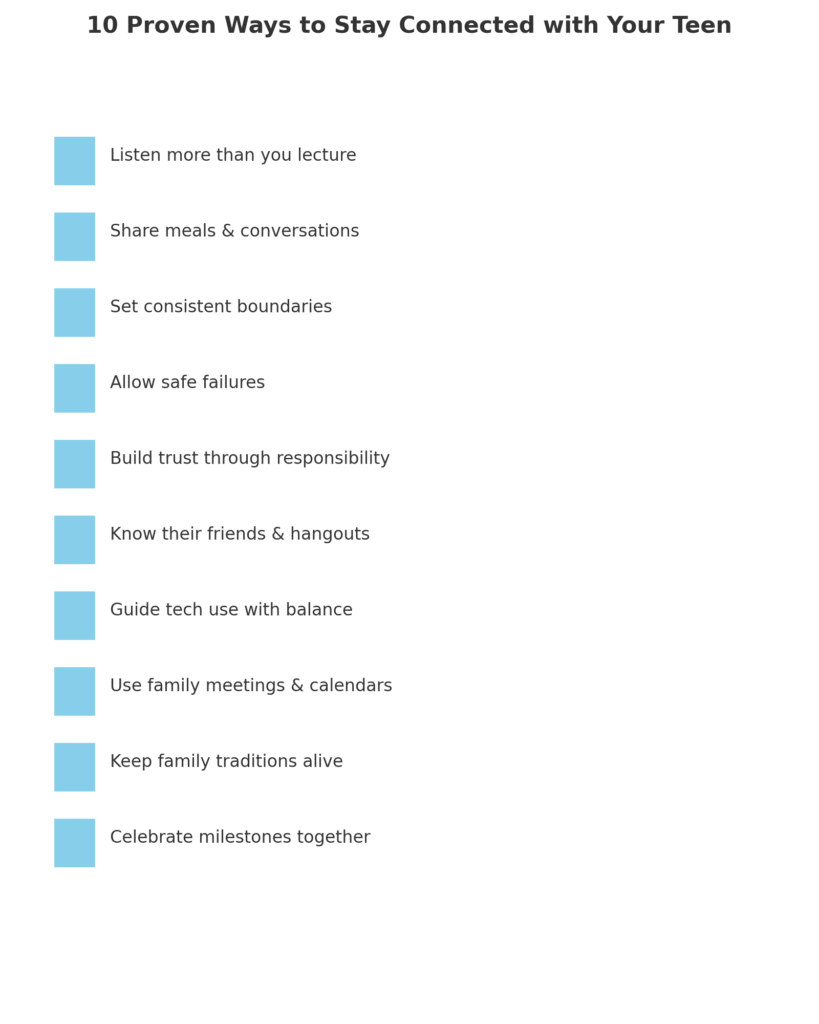
More from Our Family of Blogs:
Lifetime Family Journey – Stories, guides, and lessons from life in a big family.
Mountains Will Move – Faith, resilience, and encouragement for life’s hardest battles.
Everyday Exposed – Real talk on culture, media, and the world we’re raising our kids in.
